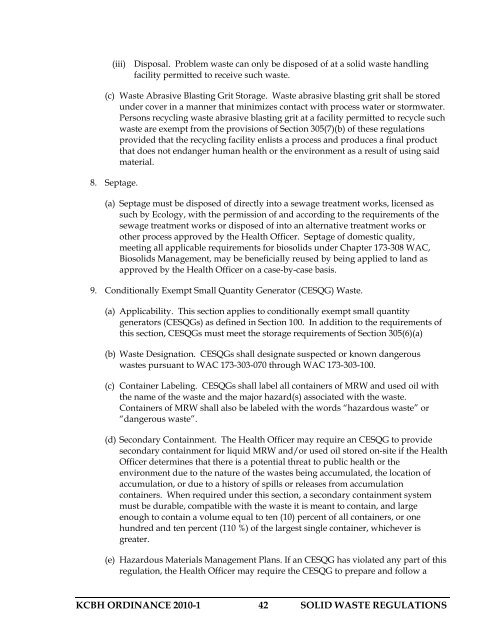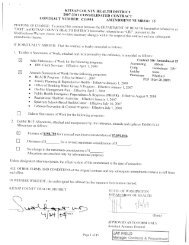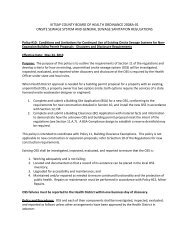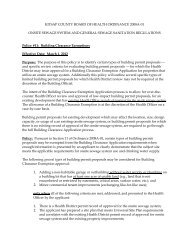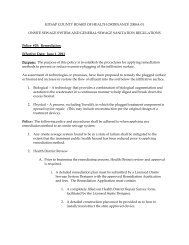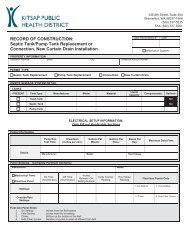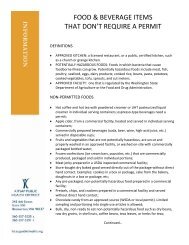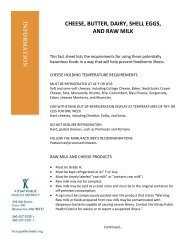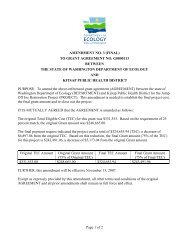SOLID WASTE REGULATIONS - Kitsap Public Health District
SOLID WASTE REGULATIONS - Kitsap Public Health District
SOLID WASTE REGULATIONS - Kitsap Public Health District
You also want an ePaper? Increase the reach of your titles
YUMPU automatically turns print PDFs into web optimized ePapers that Google loves.
(iii) Disposal. Problem waste can only be disposed of at a solid waste handling<br />
facility permitted to receive such waste.<br />
(c) Waste Abrasive Blasting Grit Storage. Waste abrasive blasting grit shall be stored<br />
under cover in a manner that minimizes contact with process water or stormwater.<br />
Persons recycling waste abrasive blasting grit at a facility permitted to recycle such<br />
waste are exempt from the provisions of Section 305(7)(b) of these regulations<br />
provided that the recycling facility enlists a process and produces a final product<br />
that does not endanger human health or the environment as a result of using said<br />
material.<br />
8. Septage.<br />
(a) Septage must be disposed of directly into a sewage treatment works, licensed as<br />
such by Ecology, with the permission of and according to the requirements of the<br />
sewage treatment works or disposed of into an alternative treatment works or<br />
other process approved by the <strong>Health</strong> Officer. Septage of domestic quality,<br />
meeting all applicable requirements for biosolids under Chapter 173-308 WAC,<br />
Biosolids Management, may be beneficially reused by being applied to land as<br />
approved by the <strong>Health</strong> Officer on a case-by-case basis.<br />
9. Conditionally Exempt Small Quantity Generator (CESQG) Waste.<br />
(a) Applicability. This section applies to conditionally exempt small quantity<br />
generators (CESQGs) as defined in Section 100. In addition to the requirements of<br />
this section, CESQGs must meet the storage requirements of Section 305(6)(a)<br />
(b) Waste Designation. CESQGs shall designate suspected or known dangerous<br />
wastes pursuant to WAC 173-303-070 through WAC 173-303-100.<br />
(c) Container Labeling. CESQGs shall label all containers of MRW and used oil with<br />
the name of the waste and the major hazard(s) associated with the waste.<br />
Containers of MRW shall also be labeled with the words “hazardous waste” or<br />
“dangerous waste”.<br />
(d) Secondary Containment. The <strong>Health</strong> Officer may require an CESQG to provide<br />
secondary containment for liquid MRW and/or used oil stored on-site if the <strong>Health</strong><br />
Officer determines that there is a potential threat to public health or the<br />
environment due to the nature of the wastes being accumulated, the location of<br />
accumulation, or due to a history of spills or releases from accumulation<br />
containers. When required under this section, a secondary containment system<br />
must be durable, compatible with the waste it is meant to contain, and large<br />
enough to contain a volume equal to ten (10) percent of all containers, or one<br />
hundred and ten percent (110 %) of the largest single container, whichever is<br />
greater.<br />
(e) Hazardous Materials Management Plans. If an CESQG has violated any part of this<br />
regulation, the <strong>Health</strong> Officer may require the CESQG to prepare and follow a<br />
KCBH ORDINANCE 2010-1 42 <strong>SOLID</strong> <strong>WASTE</strong> <strong>REGULATIONS</strong>


